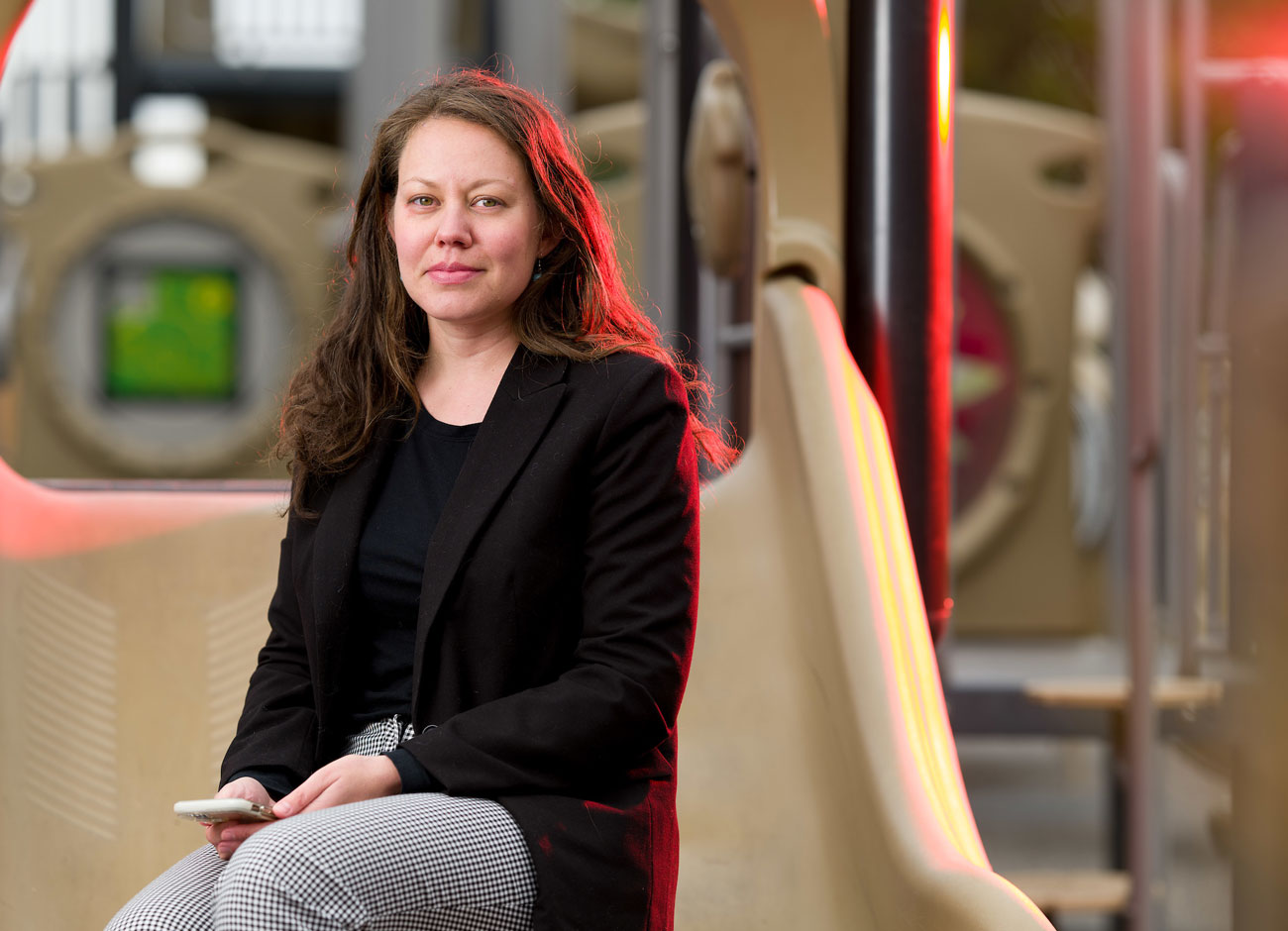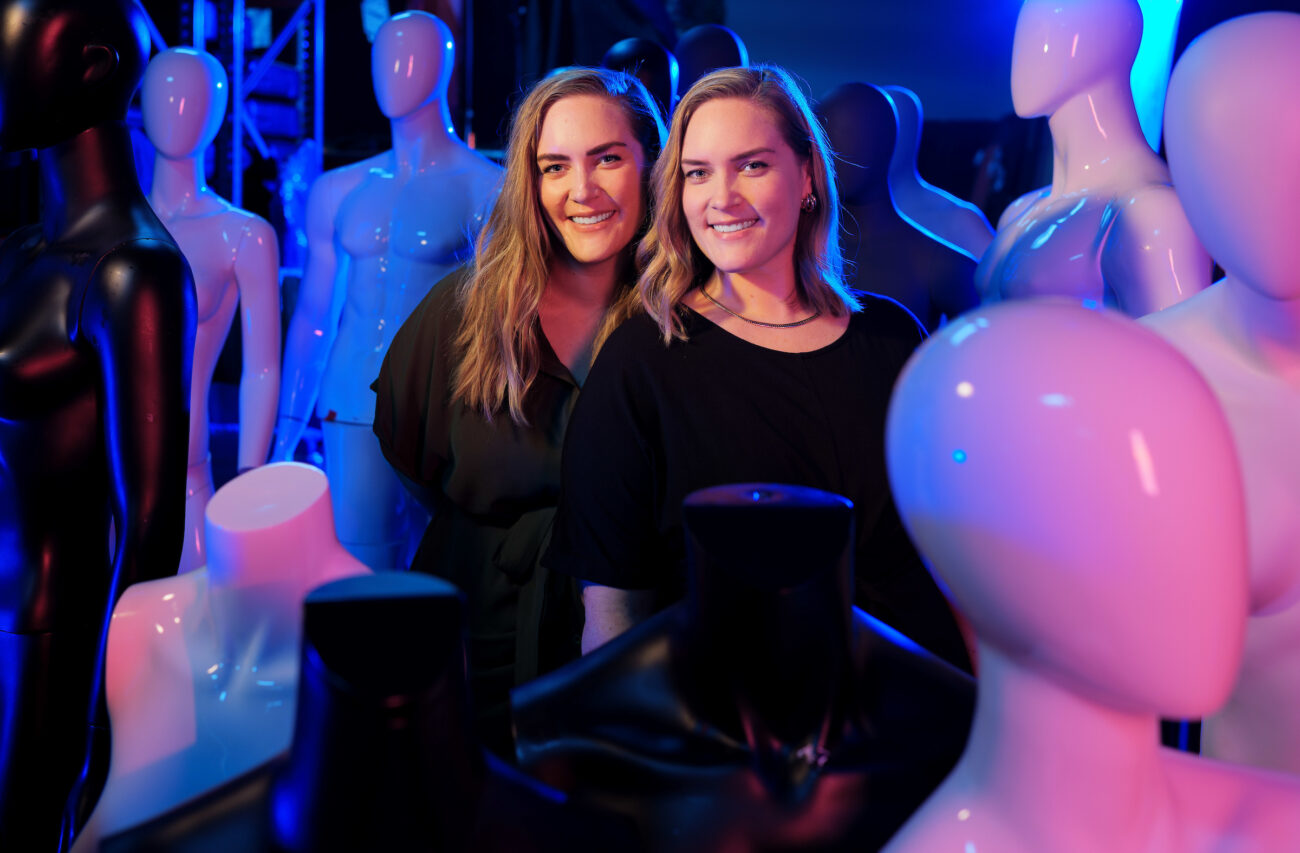Upstanding and the Science of Fighting Bullying

Diana Meter doesn’t like to talk about it, but she has first-hand experience with bullying.
“People say that you shouldn’t be attached to your research, but I was bullied as a middle schooler, and watching my peers in that situation was very interesting to me and,” explains Meter, an assistant professor of human development and family studies.
A North Carolina native, Meter was part of a “tight-knit” group of friends who rode the bus, hung out at school, and competed on the swim team together. But after her boyfriend broke up with her and started dating another member of the group, Meter says, “at that point they all just kind of shut me out.”
“It sounds silly now talking about it as an adult, but it was really hard for me to go from feeling very accepted and very comfortable with a group that I could rely on and tell my secrets to, to suddenly feeling very isolated,” Meter adds. “It took me quite a while to have the trust to build friendships again.”
Meter, who has taught at Utah State University since 2017, graduated with a bachelor’s in psychology from the University of North Carolina Asheville, then completed a master’s and a Ph.D. at the University of Arizona where she researched the benefits and consequences of defending against bullying.
Meter has continued research in this vein since coming to USU, and she was heartbroken by the suicides of two young Utah students last winter.
Ten-year-old Isabella “Izzy” Tichenor took her own life in November 2021 after her family said she was subjected to racism and bullying due to her disabilities in Davis County. And in February, 12-year-old Drayke Hardman died by suicide in Tooele County after his parents said he was relentlessly bullied by a classmate who continued to torment him even after being suspended from school.
We asked Meter to share the impacts of bullying, and what caregivers and teachers can do to better protect students from bullying. This conversation has been lightly edited.
Learn more about Dr. Diana Meter’s work during on June 7, 2022 at a Blue Plate Research talk “Defenders, Bullies & Victims: The Social Ecology of Adolescence.” The event will be 11:30 a.m. to 1 p.m. at Gallivan Hall in downtown Salt Lake City.
Jeff Hunter: Why is middle school such an important time during a child’s social development?
Diana Meter: Friendships and peer acceptance are so important, especially as early adolescents (children 10 to 13 years of age) and teenagers start to differentiate themselves from their families a little bit and those peer relationships become even more important. So, when children don’t have that fulfillment of the need to belong, it can be really difficult for them. And it’s related to internalizing problems like depression and anxiety. But sometimes children will also act out with more aggressive behavior like delinquency to deal with some of those feelings.
Identity development is also something that begins during early adolescence when children are starting to think about: Who am I? What makes me, me? And so, young people are paying a lot of attention to social norms. “What’s acceptable? What’s unacceptable?” They see why other people are getting positive peer regard, while other people are getting rejected. Adolescents are really focused on that.
We see children who have bigger bodies get bullied as well as those whose gender or sexual identity don’t fit the norm. There’s also this idea of the imaginary audience where early adolescents seem to feel like everybody’s paying attention to them and watching them. Even though it might not be true, there’s this phenomenon of young people feeling as if it is, and so youth might be hyper-focused on presenting themselves in the way that will be accepted by their peer group.

JH: How beneficial is it for a child to have an upstander — someone willing to say or do something to stick up for someone that is being bullied — in their life?
DM: Research shows that youth who are defended by even one person versus those who are defended by no one tend to fare better. So, it matters; we know that it matters. But something that I’m personally concerned about and want to research is, is it risky to be a defender? You’re standing up to a powerful bully. Although defenders can help their victimized peers, I would never want a child to put themselves at risk by standing up to a bully. But we do see that most people who stand up for peers who are being victimized tend to have some social status. They have a peer group. They have friends. They also tend to have empathy and social intelligence. Those might be more individual characteristics, but it could also be that these children are being taught to think about others’ emotions and feelings and are aware of what’s going on with their peers.
And there are different ways to defend. It doesn’t always have to be jumping into the middle of physical fight or putting yourself in harm’s way. Defending could also be just walking between classes with someone so they’re not at risk of victimization. Children tend to be victimized in the hallway or on the bus — places where there are fewer adult eyes. So, being a barrier and just being with that person and sitting with them at lunch could help. Or even sending a text message saying something like, “I’m on your side. That wasn’t right.”
JH: It feels almost like a cliché from TV or movies when another kid, particularly someone more popular, sticks up for someone that’s being bullied. But is that actually reality?
DM: Oh yeah. It can totally help. But something that we don’t know much about is, does it matter who that person is? I’m going to give you a personal anecdote because I don’t think we have research on this. But growing up, I remember there was a cool male teacher, which during my time at my school was a rare thing. He was also the basketball coach and people thought he was the best thing. And he always made a point of sitting with some of the adolescents who were considered to be rather nerdy at lunch, and it lifted them up. Because the cool basketball coach gave them attention they were no longer targets. No one was going to mess with these children.
So, that’s an example of an adult intervening. But I think we can see this too with children who have a little bit more social savvy in the peer group and have some positive peer regard, who are going to put themselves at less risk if they defend. There is some research that shows sometimes it is victims defending each other, but we don’t know, if that’s just as effective. The reason I brought up the teacher is it’s part of creating a school climate where defending is cool and social acceptance and open-mindedness are the norm. And I’m thinking about some of the examples that we’ve heard about in the media where a child might be on the receiving end of racial slurs, and nobody’s saying anything, even though teachers and administrators are aware of it. That’s setting up a social situation where the students aren’t getting the message that this is unacceptable. It takes creating a norm in the school environment where everyone is on board and saying, “We don’t tolerate this stuff.”
JH: So, for someone who studies bullying, it must have been particularly upsetting to hear about Izzy Tichenor and Drayke Hardman feeling so tormented that they felt the only resort was to take their own lives.
DM: It was shocking for me to read about those events and it just makes you wonder, What is going on in our culture right now that makes that type of bullying acceptable? The state of Utah collects data on bullying. Every year they survey children and they ask, “Have you been bullied?” And if you say “Yes,” then you get a list of reasons. Popularity is always one that comes up. And looking different than other people is also one that’s very prevalent.
But what’s interesting is that there are some reasons for being bullied for which there are really small percentages such as race/ethnicity, sexual orientation, and gender-related bullying. But we’re talking about small sub-groups of the population who would be vulnerable to this type of bullying, so even though the percentages are small, the prevalence of these problems may be quite large among individuals with marginalized identities. Other research from GLSEN, an organization that collects statewide data to the best of their ability, tries to get LGBTQ+ children specifically to report victimization, and some of their findings about the prevalence of gender and LGBTQ+-related bullying in Utah is pretty shocking.
JH: So, what can parents do to help their children deal with bullying, particularly when bullying doesn’t just take place in a face-to-face setting, but can happen online, as well?
DM: Generally, parents can pay attention to any change in their child’s behavior. If they’re withdrawn, if they don’t want to go to school, if they don’t want to go online and do their normal social networking activities, those could all be signals that something is going on.
It’s also important for parents to at least be friends with their children on the social networking sites and be aware of as much as possible. And they should definitely be aware if their children are friends with people they don’t know, which is a risk factor for all sorts of other reasons. Stopbullying.gov and Cyberbullying.org have resources for parents, students, educators, and adult victims. There is information about being cyber aware and about how to keep their children safe, not just from cyberbullying but from cyber predators and other things that can go wrong in digital spaces.
JH: What about the idea that enduring bullying can make a child stronger?
DM: There’s no evidence to suggest that is true. Bullying is a repeated behavior and there’s a power imbalance between the victim and the aggressor. That’s different from when there are two friends who have a conflict and have to work it out and overcome whatever the issue is — that is good for child development. Especially when children or adolescents can get support from parents and others about how to deal with that situation.
With bullying, children aren’t necessarily able to defend themselves because of a power imbalance, which can be physical size, social status, ability, or other factors. In that situation, especially when there’s nobody standing up for them and defending them, it’s just going to wear a child down. It’s not giving a child an opportunity to practice social skills because they’re not able to actually work through that conflict. That’s one of the things that makes peer victimization unique from just peer conflict. And as far as I know, there’s absolutely no research to suggest that true bullying is related to any positive outcomes. In fact, there’s research to suggest that children who are bullied when they’re younger sometimes continue to have problems into adulthood.
JH: It does seem like children, parents, and educators are more aware of bullying and harassment and doing something about than when some of us were kids.
DM: One of the major changes that has taken place over the last 20 or 30 years is that we now recognize this is bad. We don’t tell children to, ‘Suck it up. It will make you stronger’ because we know it’s harmful. And so now children are encouraged, if this happens, to say something. To tell an adult. Tell a teacher. Tell an administrator.
And the expectation is that they’re going to actually help, right? And so, one of the best things that we can do is just listen. For instance, an adolescent might say, ‘My boyfriend dumped me and now he’s dating my friend and none of my friends will talk to me.’ That might sound very silly to an adult, but that’s huge to that child. Being that listening ear and maybe even role playing to figure out ways to deal with the situation like, ‘Oh, so they won’t let you sit with them on the bus? What can you do instead?’ Just try to give children options and expectations for how they can overcome the situation.
JH: Is there anything else that you think would be beneficial for parents to know?
DM: There are resources. And if parents are not getting the help that they need from the school they should go the next level up and make sure that something is done about bullying, because if their child is experiencing this, their child is not the only one. And it’s up to the greater school community to build safer school climates where all youth can thrive. Of course, there’s going to be some conflict and some teasing. But educational administrators need to ensure that it doesn’t become a pattern and become so impactful that it’s devastating to children during this important developmental period.






